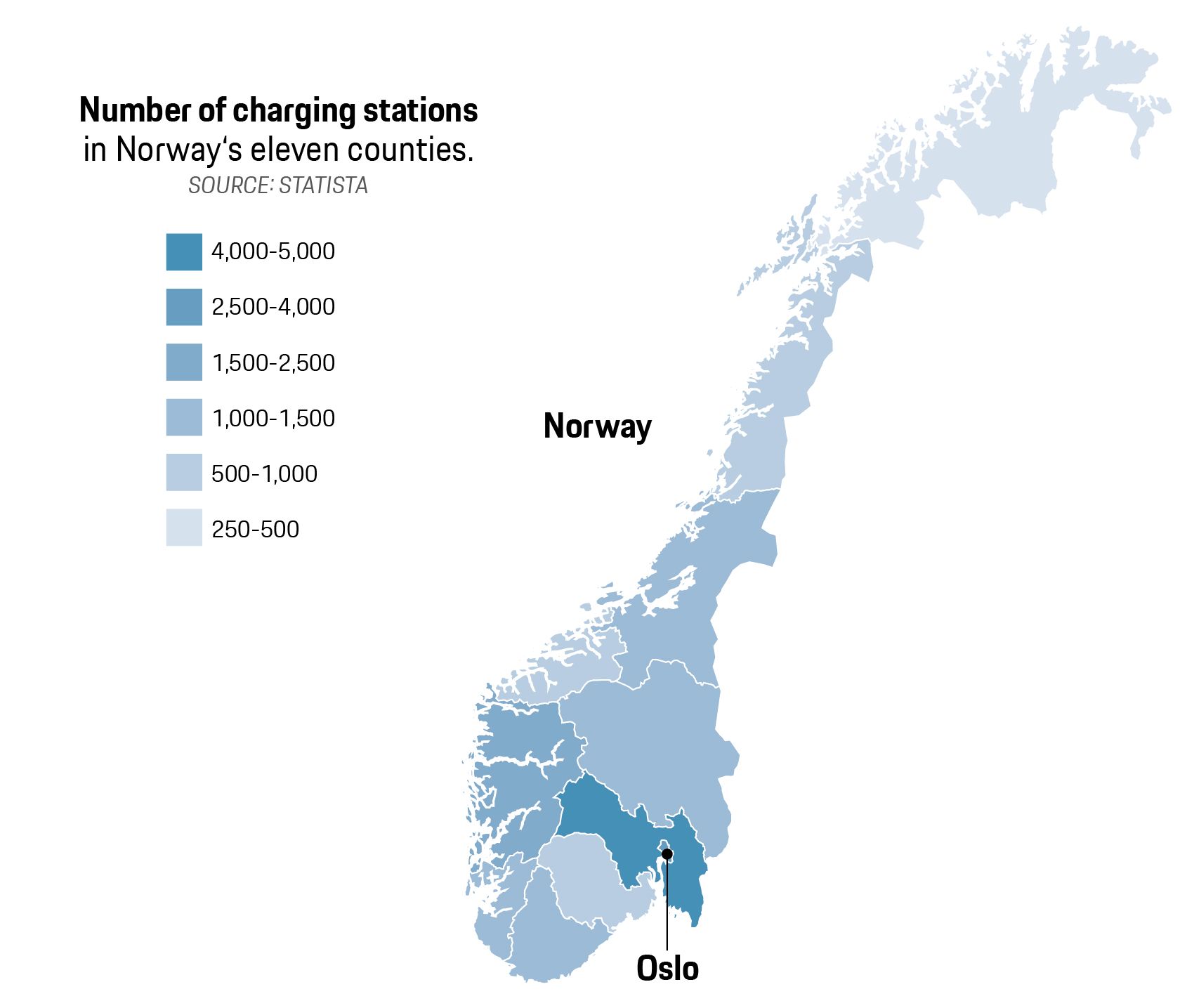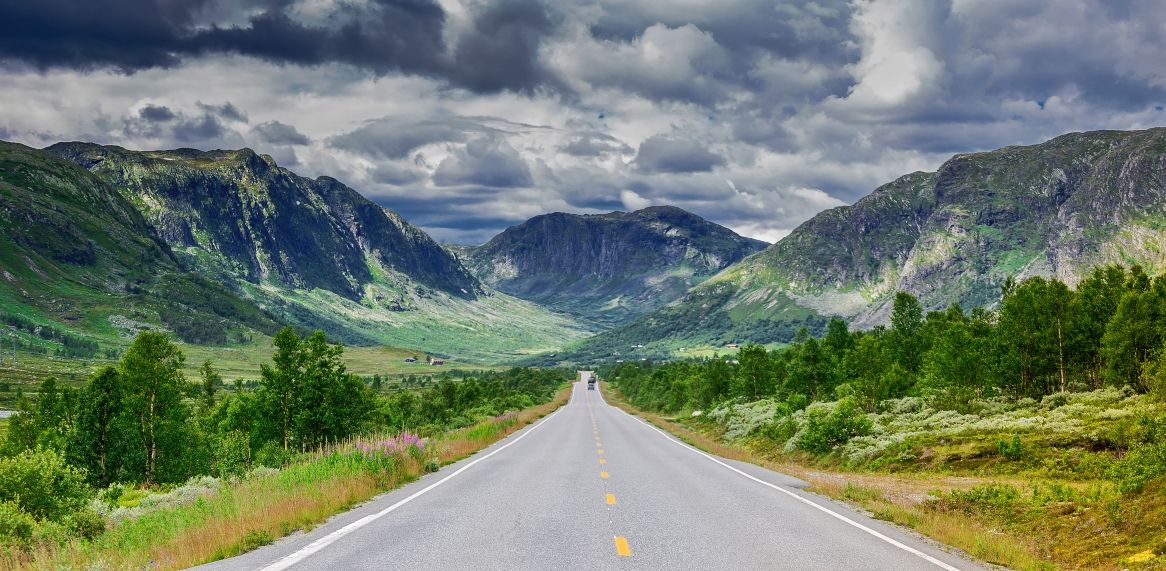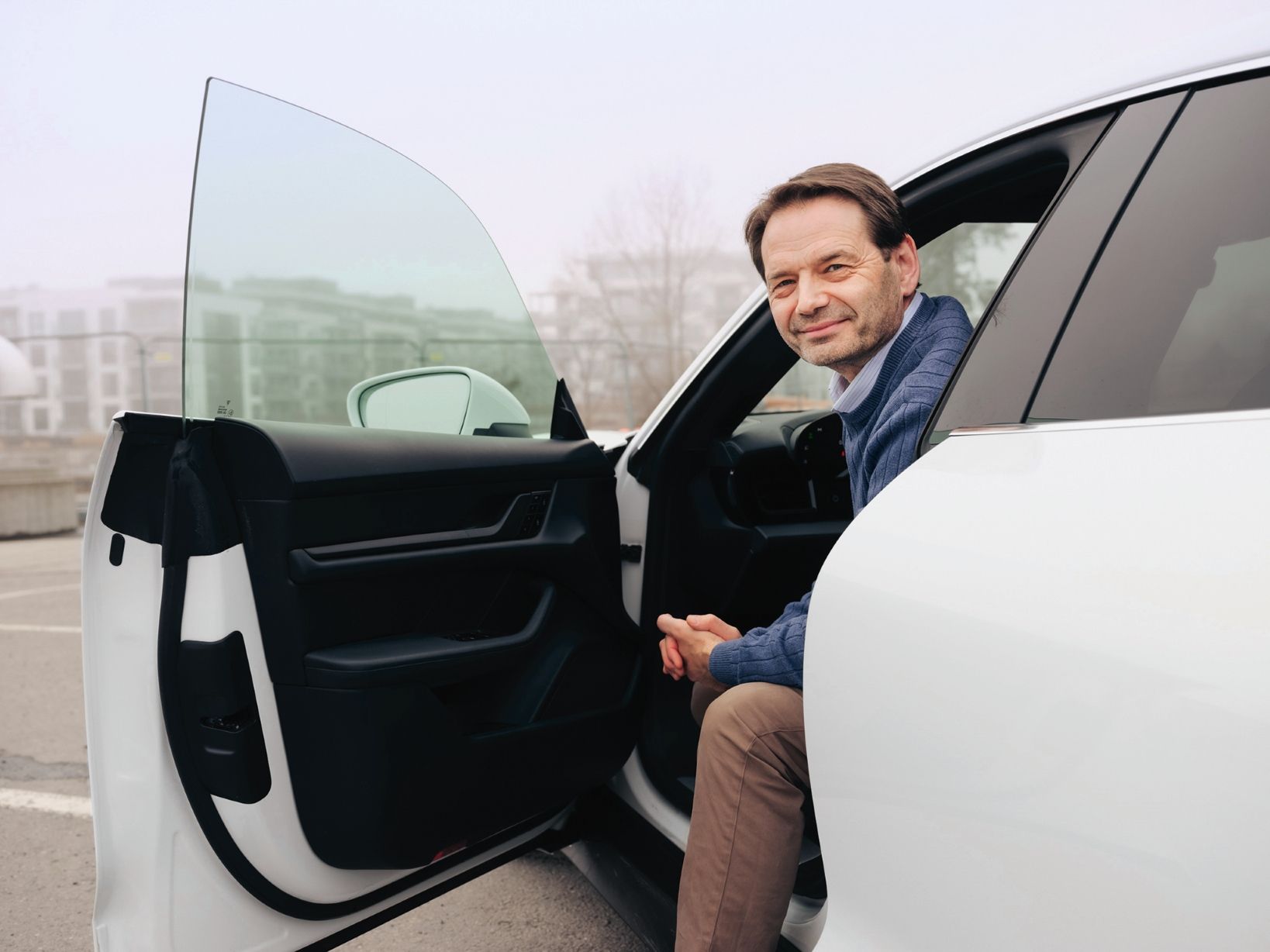
Norway Leads the Way in Everyday E-Mobility
A Country Electrified
Norway is one of the world’s pioneers in the field of e-mobility. More than half of the new vehicles registered there in 2020 had an all-electric powertrain. In addition to modern design and innovative technology, Norwegian customers also want vehicles that offer a long range and sufficient space for the family. Ideal conditions for the Porsche Taycan and the new Porsche Taycan Cross Turismo.
Norwegian Erling Henningstad loves fast and dynamic cars with good handling. And he has known for many years that you don’t necessarily need an internal combustion engine to achieve it. The IT entrepreneur from the Oslo area bought his first electric car back in 2012, and some 250,000 km later he knows the new powertrain system inside out. Talking to Henningstad, it becomes clear: the Norwegian Porsche customer is passionate about technology and meticulously researches every aspect of his car.
So when Porsche opened the reservation list in 2018 for what was then still called the “Mission E,” he didn’t have to think twice—and was one of the first customers in Norway to sign the order for a car of which he had only seen a sketch and the basic technical data. “I’ve always dreamed of owning a Porsche,” Henningstad says. “And when an electric model became available, that dream could finally come true. I knew: This will be my car.”
Erling Henningstad has been the owner of a Porsche Taycan 4S Performance Plus since July 2020. “The Taycan 4S offers a lot for the money,” says the 59-year-old software expert. For the equipment package, he opted for a large battery with 93 kWh of capacity, a 150 kW DC charger, a heat pump, Adaptive Cruise Control (ACC), and Surround View . His favorite feature is the battery temperature gauge, which is important for both charging and performance. “Few cars offer that,” he says. “But the display is very useful with varying usage and changing seasons.”

Sparsely Populated: Norway is about the size of Germany, but has only around 5.4 million inhabitants.

Best Seller: The Taycan has allowed Porsche to double its sales in Norway.
Impressive Charging Speed
Henningstad was positively surprised by the range of his electrically powered Porsche: “It was absolutely sufficient in both summer and winter—and I drove my Taycan in temperatures as low as minus 30 degrees,” says Henningstad. Range anxiety—rekkeviddeangst in Norwegian—is certainly not an issue for him. “The dreaded battery drain is also no problem with the Taycan—unlike other electric cars, which noticeably lose charge when stationary for a long period,” he says.
The Porsche fan was also impressed by the charging speed: at a rapid charging station with a capacity of 350 kW, the battery was half-charged in just ten minutes. “It’s almost on-par with fossil fuel cars in terms of fueling time,” Henningstad comments cheerfully.
~
19,000

The fact that Henningstad can hardly tell the difference between his Taycan and a conventionally powered vehicle is due in no small part to the extensive support for e-mobility in Norway. There are almost 19,000 charging stations around the country, so e-car drivers will find at least two rapid charging stations every 50 km on almost all major roads. There are more than 350 charging stations per 100,000 inhabitants in Norway, which puts the country in second place in Europe behind the Netherlands (386). Germany has approximately 54 charging stations per 100,000 inhabitants. The excellent charging infrastructure is not the only argument in favor of switching to e-mobility; the costs per km are also compelling: Most of Norway’s electricity comes from hydroelectric power, which is why green electricity is cheaper there than fossil fuels such as gasoline and diesel.
In addition to a nationwide charging infrastructure and low electricity prices, drivers of e-cars in Norway also benefit from various government incentives. For example, the 25 percent value-added tax is waived if a customer decides on an electric vehicle. In addition, no extra taxes are levied based on emissions and weight, as is the case with fossil-fuel cars. Beyond the financial advantages, there are further benefits on the road: e-vehicles are allowed to use city bus lanes, for example—an invaluable advantage during rush hour. And they get to park for free in many places.



Adventurous: Erling Henningstad is on the road a lot and likes to spend weekends in the countryside. A long range is particularly important to him.
Only Zero-Emission New Cars from 2025
The enthusiasm for electrically powered cars goes back a long way in Norway. As early as the 1970s, the Strømmens Verksted company began experimenting with electric vehicles. Later, ABB Battery Drives developed a powertrain that was used on a trial basis in the VW Golf Citystromer in 1989. A series of road tests followed from 1990 to 1999, including the Ford Think. Intensive government support for e-mobility in Norway began just over 30 years ago. At that time, the environmental group The Bellona Foundation and the pop stars of a-ha launched an initiative to abolish the fees for electric cars, which gained majority support in 1990. Since then, e-vehicles have become an ever-more-frequent sight on Norway’s roadways. Meanwhile, the country is fully committed to sustainable drive technologies: starting in 2025, only zero-emission cars are to be registered in Norway.
~
77,000
~
54
%
~
400,000
It’s no wonder, then, that the majority of Norwegian customers are already opting for electric vehicles: nearly 77,000 electric vehicles were sold there in 2020, representing some 54 percent of all newly registered vehicles—not including plug-in hybrids, which actually put the share of electrified cars at nearly 75 percent. And the boom has continued this year as well: in March, 56 percent of all new cars sold were electric models. Despite its population of roughly 5.4 million, this puts Norway in fourth place in the world for electric vehicle sales, and nowhere in Europe are there more electric cars per capita.
Thanks to high demand, the total number of electric vehicles sold in Norway will be approximately 400,000 by the end of 2021. The Taycan is also benefiting from the electric euphoria: launched on the Norwegian market in January 2020, the thousandth Taycan customer was able to take delivery of their vehicle at the beginning of November 2020. The sales launch of the all-electric sports car ensured that Porsche sales in Norway doubled over the same period of the previous year.

Cheap Energy: Thanks to hydroelectric power, green electricity is cheaper in Norway than gasoline and diesel.

Extensive Network: Drivers of electric cars will find plenty of charging stations in Norway, even in the countryside.
Perfect for a Wide Range of Conditions
Erling Henningstad has not regretted his choice for a second and is completely satisfied after his first months as a Taycan owner. “The interior of the car is stylish and feels solid,” he says approvingly. “And the driving characteristics are phenomenal: with its low center of gravity, the Taycan is well balanced and offers full control regardless of the conditions.” He’s particularly pleased that he can change many of the electric sports car’s characteristics, such as engine response, suspension settings, and electronic stabilization, to suit his tastes, mood, or the current ambient conditions. This enables it to cope perfectly with a wide range of conditions. “The Taycan can handle everything from race tracks to gravel roads,” says Henningstad, summing up his experience so far.
~
1,600
95
%
Being able to handle roads of all kinds with confidence is particularly important in Norway, where almost all families own a weekend home by the sea or in the mountains. A car that can also cope well with dirt roads is therefore indispensable. Customers also want sufficient space for several passengers, including sports equipment. This makes the new Porsche Taycan Cross Turismo particularly suitable for the Norwegian market. “All indications are that it will be a perfect fit for adventurous people like me who appreciate back roads and extra space,” says Henningstad. “I also expect it to drive as superbly as you’d expect from a Porsche. And if it really does handle better on rough roads with the raised ride height, the Taycan Cross Turismo could put the perfect car for me within reach.”
Questions to Thomas May, Director Area Northern Europe at Porsche AG

“Norway is five years ahead of many countries with regard to e-mobility.”
Thomas May
Director Area Northern Europe at Porsche AG
What are the specific requirements of customers in Norway?
MAY: They focus on top quality and are very design-savvy. Many Norwegians also have a hytte, a small house in the mountains or on a fjord. They spend almost every weekend there. They want cars with four-wheel drive that offer enough space for the family and luggage. And they need vehicles that function reliably even in sub-zero temperatures.
What new target group could the Taycan Cross Turismo tap into?
MAY: It is particularly interesting for customers with high space requirements, such as families with children. The press, in any case, have dubbed it “a dream car” and “a Porsche made for Norway”—at least these are two of many recent headlines. We expect that the Taycan Cross Turismo will have a large market share. So far we have more than 1,700 prospective buyers and have received over 700 orders. A good start!
What can other countries learn from the e-car boom in Norway?
MAY: Norway is about five years ahead of many countries, and e-mobility is completely commonplace there. Drivers of e-cars also benefit from other advantages in addition to government support, such as an e-car-only parking garage in Oslo. Range is also no longer a problem, with nearly 1,000 new rapid charging stations installed in 2020 alone. This is how you make e-mobility attractive and convenient for customers. That makes all the difference.
In other words, with the right incentives, everywhere could be like Norway in a few years’ time?
MAY: All the basic questions regarding e-mobility— range anxiety, the installation of charging stations at home—are no longer an issue in Norway. People have total confidence in electric vehicles and have grown to love them. While they were initially only used as a second or third vehicle, they have now become the car for daily use. In a few years, this could also be the case here, if the right conditions are created.
What can be learned from Norway with regard to sales?
MAY: Today, “depositor programs” are standard there: even before the official start of sales, you can register online as a prospective buyer and make a deposit. So communication with interested parties begins very early and in a targeted manner. The customers themselves also talk to each other. In the private Facebook group “Porsche Taycan Norway,” which they initiated and which has more than 5,000 members, they report on their experiences, give each other tips on operation, or get information on equipment before placing the final order.
Info
Text first published in the Porsche Engineering Magazine, issue 2/2021.
Text: Eric Røkeberg
Photos: Ilja C. Hendel
Copyright: All images, videos, and audio files published in this article are subject to copyright. Reproduction in whole or in part is not permitted without the written consent of Porsche Engineering. Please contact us for further information.
Contact
You have questions or want to learn more? Get in touch with us: info@porsche-engineering.de
Consumption Data
Taycan 4S
Power consumption (combined) (performance battery): 26.2 kWh/100 km
Power consumption (combined) (performance battery plus): 27.0 kWh/100 km
CO₂ emissions (combined): 0 g/km
Energy efficiency class: A+
Taycan 4 Cross Turismo
Power consumption (combined): 28.1 kWh/100 km;
CO₂ emissions (combined): 0 g/km;
Energy efficiency class: A+
Taycan 4S Cross Turismo
Power consumption (combined): 28.1 kWh/100 km;
CO₂ emissions (combined): 0 g/km;
Energy efficiency class: A+
Taycan Turbo Cross Turismo
Power consumption (combined): 28.7 kWh/100 km;
CO₂ emissions (combined): 0 g/km;
Energy efficiency class: A+
Taycan Turbo S Cross Turismo
Power consumption (combined): 29.4 kWh/100 km;
CO₂ emissions (combined): 0 g/km;
Energy efficiency class: A+

